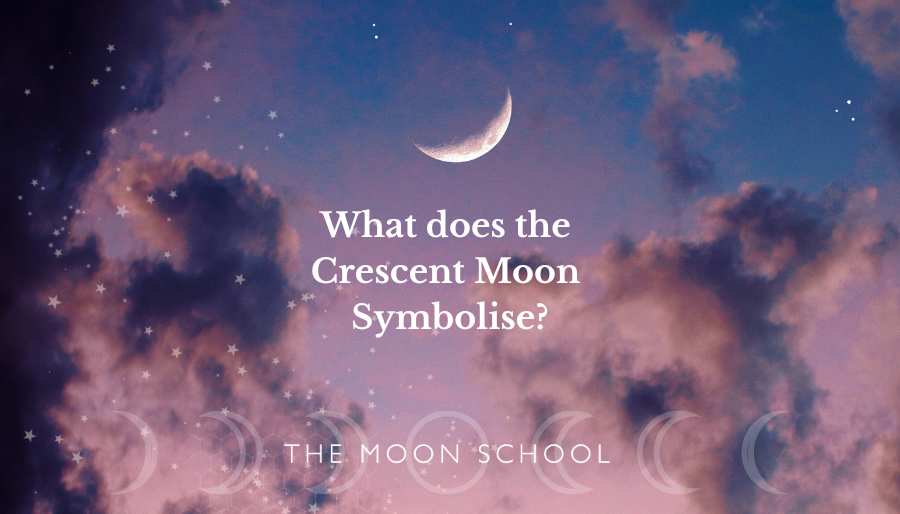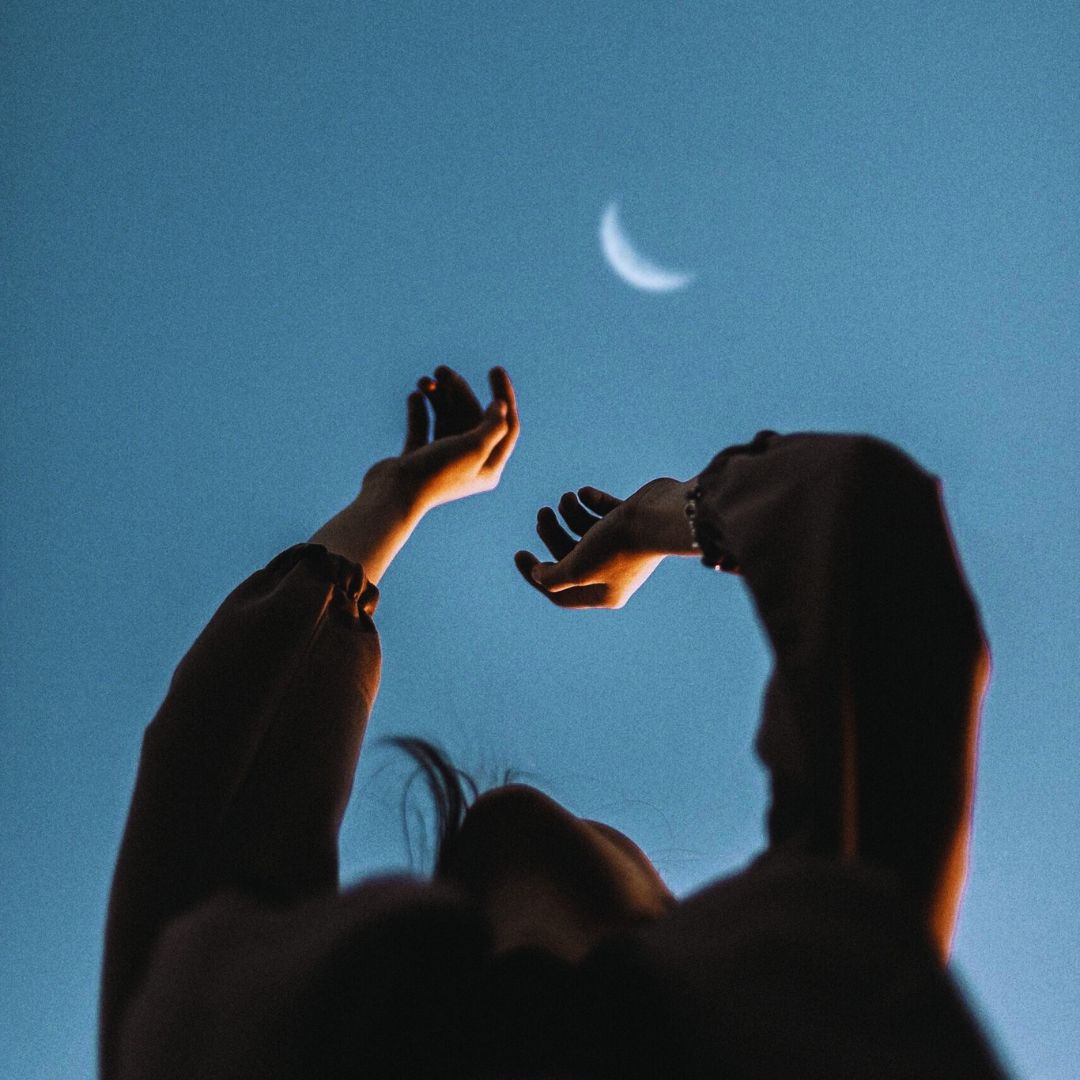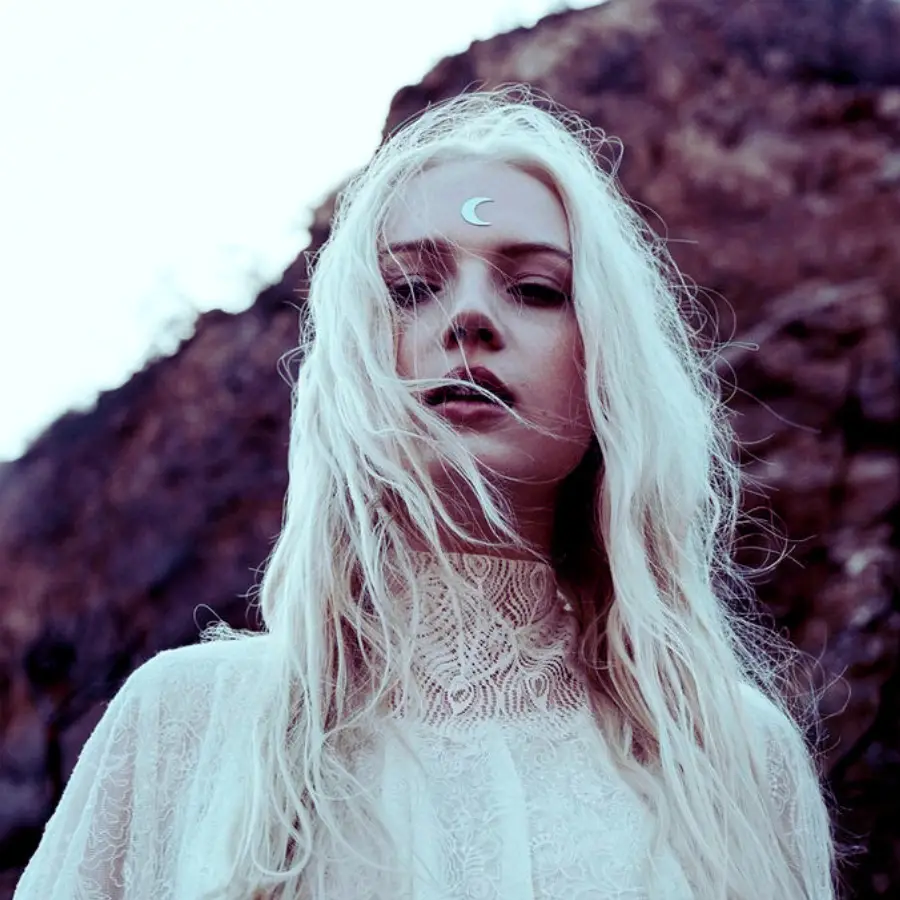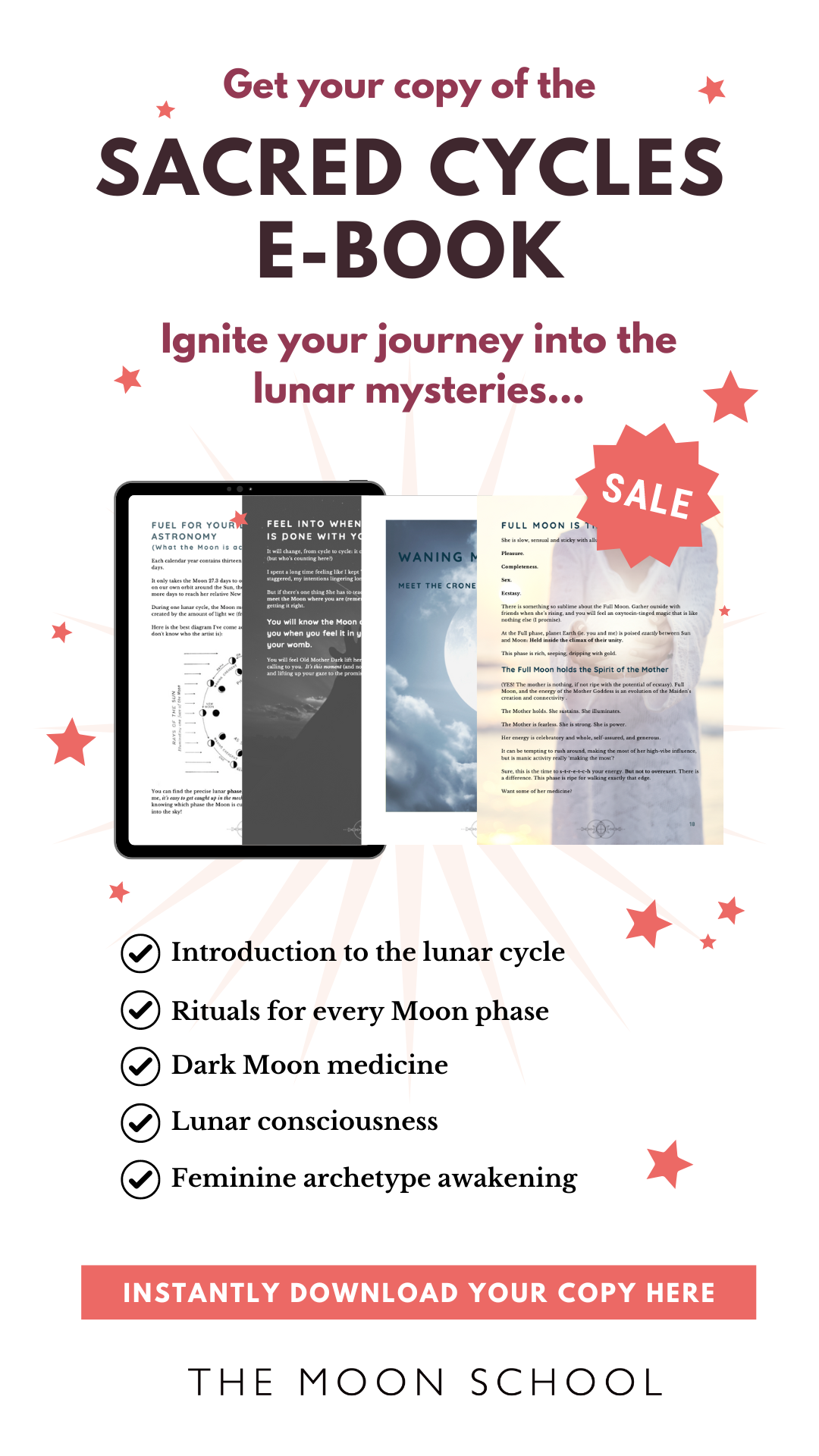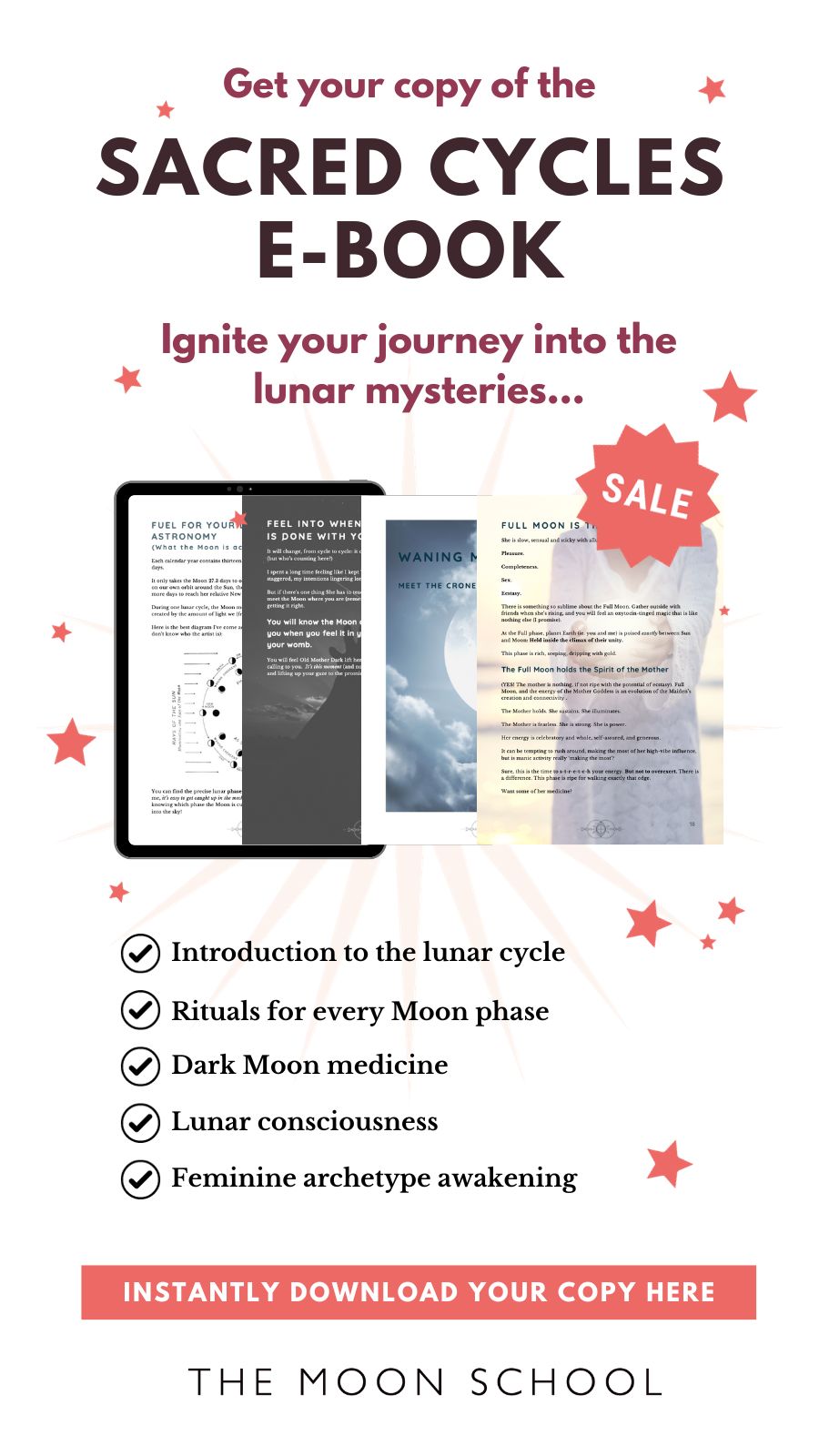Have you ever looked up to see a sliver of celestial light, hanging low in the sky like a cosmic smile? That’s the enigmatic beauty of the crescent Moon, a beautiful sight and fascinating phenomenon that’s inspired wonder and intrigue across cultures and eras….
From science to symbology, astrology and feminine mysteries, there’s a LOT contained in this delicate arc of light. Let’s take a look…
What is a crescent Moon?
The crescent moon is a phase of the Moon resembling a curved or bowed shape. The crescent appears twice in a lunar cycle – as the waxing crescent Moon and the waning crescent Moon.
During both of these phases, the lit-up part of the Moon is only a small portion, appearing as a delicate arc of luminescence on one side of the Moon. The opposite half remains in darkness.
The slim smile of this lunar phase is a fleeting phase of the Moon, visible just before the first quarter, or after the last quarter. Whether as a waxing or waning Moon, this phase is most commonly seen low in the western sky around the tranquil hours of dawn or dusk.
Although it is sometimes colloquially referred to as the ‘half moon,’ technically that term is reserved for the first and last quarter moon phases, which are distinct from the crescent phase.
In the sky, the crescent Moon’s appearance can be influenced by a few factors, like the observer’s geographical location, the time of the year, and the time of day.
For example, in the Northern Hemisphere, the best conditions for observing the crescent Moon tend to occur from January through to March. The tropics offer a stunning year-round view of a smiling crescent, whilst in the northern polar regions, the crescent appears sideways.
Crescent Moon etymology
The term ‘crescent’ itself originates from the Latin verb ‘crescere,’ meaning ‘to grow,’ referring to the waxing or growing moon – the “luna crescens”.
Waxing Crescent Moon
Straight after the new Moon phase, a slim smile of light emerges over the Moon’s surface, signalling the onset of the waxing crescent Moon phase. This occurs when the Moon is approximately 30º and 90º behind the Sun, and manifests as a slender band, along one illuminated side edge of the Moon, visible in the sky for almost a week.
The waxing crescent Moon appears when the lunar light we see reflected across the Moon’s surface increases from 0.1% to 49.9%, indicating the shift from the new Moon to the first quarter Moon phases.
The Waxing Crescent Moon rises in the daytime before midday, so is visible during the daytime, falling below the western horizon before midnight.
The waxing crescent Moon phase lasts for approximately 5 days and marks the beginning of the waxing parts of the lunar phases.
Waning Crescent Moon
The waning crescent Moon appears close to the end of the lunar cycle, as the Moon finishes its Earth orbit and moves towards the next lunar cycle. This phase occurs when the Moon is approximately 30º to 90º ahead of the Sun on her orbit. This phase can be recognized by a thin sliver of moonlight appearing in the predawn sky.
This delicate waning Moon occurs as the lunar light we see reflected across the Moon’s surface decreases from 49.9% to 0.1%, indicating the shift from the last, or third quarter Moon to the New Moon phases.
The waning crescent Moon rises in the early hours of the morning and can be seen in the sun-lit sky before dropping below the western horizon in the afternoon.
The waning crescent Moon phase lasts for approximately 5 days, and marks the end of the waning parts of the lunar phases.
Does the Moon look different in different hemispheres?
Yes, the Moon can appear differently depending on the hemisphere you are viewing it from, as your perspective depends own your latitude. The key difference is the Moon’s orientation – in the northern and southern hemispheres, the crescent Moons appear flipped, relative to each other.
As you move further north or south, the shape of the lit part of the Moon will appear to rotate by the same degree of latitude you are traversing.
In the northern hemisphere, the horns of a crescent Moon will point to the left. And in the southern hemisphere, horns of a crescent Moon will point to the right.
All of the Moon’s phases…
If you’re curious to read about the rest of the lunar cycle, check out these posts on the eight Moon phases (well, actually there are 9!)
- New moon
- Waxing crescent
- First quarter
- Waxing gibbous
- Full moon
- Waning gibbous
- Last quarter
- Waning crescent
- Dark
These phases occur due to the geometric relationship between the Sun, the Earth, and the Moon causing the angle between each to keep changing.
The position of the Moon relative to the Earth and Sun determines which part of the Moon is illuminated by the Sun, leading to the different lunar phases we’re able to observe.
What does the crescent Moon symbolise spiritually?
Apart from its captivating appearance, the crescent Moon holds deep symbolic and spiritual significance. Throughout history, its unique form has been interpreted and reinterpreted, woven into the tapestry of human culture and belief.
Fundamentally, the crescent Moon represents femininity and the feminine life-giving principle, due to its association with the menstrual cycle and phase of growth.
Of course, the waning crescent appears close to the end of the cycle, spiritually signifying the decay and destruction, also inherent in the feminine mysteries. Together, the regular cyclic pattern of waxing and waning of the crescent Moon makes it a spiritual symbol of rejuvenation, renewal and the perpetual cycles of life, death and rebirth.
Curious about the feminine? Also read:
As the sole natural satellite seen from Earth, the Moon has come to symbolize insight, wisdom and illumination even on the darkest of nights. The delicacy of the emergent crescent Moon seems to express this even more than a fully illuminated Moon does.
Its gravitational pull is also tied to the ocean tides, so the crescent Moon came to symbolise sources of water, navigation and the fluid rhythms of nature.
In many agricultural societies, the Moon was a symbol of fertility and rebirth due to its perceived influence on the growth cycles of plants.
Across various belief systems, lunar goddesses and deities were often depicted with crescent symbols, imbuing the crescent Moon with spiritual meaning associated with the divine feminine, that has endured for millennia.
Crescents are used in astrology as symbols for the Moon (rather than representing a particular phase).
The crescent Moon is the alchemical symbol of silver.
It’s also associated with Mary, the mother of Jesus. She is sometimes depicted standing upon a crescent Moon, reflecting the vision of Saint John (Apocalypse 12:1): “A woman clothed in the sun, and the moon was under her feet.”
What does the crescent moon mean in mythology?
In Greek mythology, the crescent moon was understood to symbolise the Goddess Selene, one of the most important lunar deities. But to the ancient Greeks, the Moon wasn’t just a representation of Selene the personification of the Goddess.
In mythology, stories, and art Selene was often depicted as a beautiful woman with a crescent moon on her forehead, riding a silver chariot drawn by two white horses across the night sky.
It was believed that Selene was responsible for the changing phases of the Moon, and held sway over fertility, the mysteries of womanhood, the tides, and even the seasons of the year. Women wishing to conceive would pray to the Moon goddess Selene to help them bring new life into the world.
In Roman mythology the slender curves of the crescent shape were interpreted to symbolise the bow used by Diana, goddess of the hunt. She is often equated with Artemis, from the Greek pantheon.
In Chinese philosophy, the Moon is the yin to the sun’s yang, her changing phases a manifestation of how the female moon and the male sun can perfectly balance each other despite being opposites.
The triple Goddess and the crescent Moons
In more modern times, when grouped along with the round-bellied full Moon, the waxing crescent Moon and waning crescent shape have come to symbolise the triple goddess.
The triple Moon symbol, or “triple Goddess symbol” represents three phases of the Moon:
The triple Moon represents the movement and progression through one lunar cycle, from creation and growth, to fruition and climax, to decay and dissolution. This is the process that all of life must move through, and the triple Moon provides a symbolic depiction for us.
Along with the Moon phases, the triple Moon symbol also represents the three phases of a woman’s life: the Maiden, the Mother, and the Crone. Much like the phases of the lunar cycle, these archetypes belong together, expressing the sacredness of cycles and the never-ending spirals of life.
Meaning of a crescent Moon upside down
The upside-down crescent Moon can mean a myriad of different things, depending on the cultural context and subjective opinions. For some people, this inverted crescent shape signifies waning or diminishing feminine power, whilst for others it represents the subversion of traditional gender roles, and therefore is a symbol of rebellion against the dominant patriarchal paradigm.
The crescent Moon upside down can also represent the Goddess Lilith, a dark and powerful figure believed to be the first wife of Adam, whose origins may stretch back as far as Mesopotamia.
Inverted crescent Moons are perceived by many as a highly protective symbol. Girls in Ancient Rome used to wear amulets called Lanula, made in the shape of a crescent Moons.
Meaning of a crescent Moon with cross
A crescent Moon depicted together with a cross has different meanings to different people, but usually relates to spiritual or religious beliefs.
In Christianity, the cross is a symbol of sacrifice, redemption, and the crucifixion of Jesus Christ. As we know, the Moon is associated with femininity, intuition, and the subconscious mind. So a combination of these symbols could be interpreted as the balancing of the sacred masculine and feminine, or the physical and of spiritual realms, or a reminder of the light of Christ shining through the darkness.
The symbol of a crescent moon with a cross powerfully embodies the fusion of lunar and solar symbolism.
In other spiritual traditions, the cross and crescent Moon have different meanings. For example, in some Native American cultures, the Moon is associated with fertility, growth, and change, and the cross may symbolize the balance of opposite forces or the four cardinal directions.
Meaning of a crescent moon on the forehead
A crescent moon symbol on the forehead holds deep spiritual and cultural implications. For modern practising Wiccans, a crescent Moon on the forehead indicates a High Priestess.
Other spiritual women will paint a crescent shape on their forehead to symbolise the changing phases of womanhood and their connection to the feminine mysteries. For others, it may represent maidenhood, and perhaps virginity, due to its association with the maiden Goddesses of Artemis and Diana, for example.
In Hinduism, Lord Shiva is often shown with a crescent Moon on his head, which signals that he is the Master of Time. The crescent shape is also thought to symbolise protection and security and also reveals the feminine energy, associated with the goddess Parvati.
What do YOU feel when you see a crescent Moon?
Shaped by profound cosmic choreography involving the Sun, Moon, and Earth, the crescent Moon phase is an enchanting image and a symbolic reminder that life is ever-changing.
Over centuries, the magic and mystery of crescents have permeated many cultures and religions, symbolizing diverse deities, celestial bodies, and societal concepts.
Whether you’re looking up into the sunlight of a morning sky, or the sunset of a cloudless dusk, this delicate illuminated part of the Moon is there to offer you a moment of magic. So drink it in.

